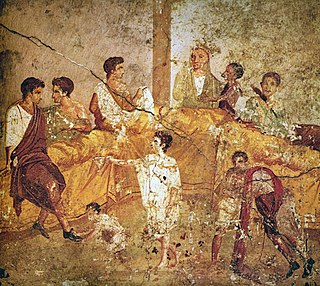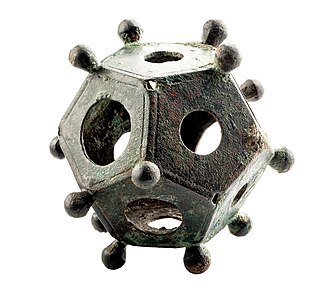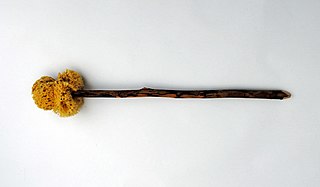 W
WThe culture of ancient Rome existed throughout the almost 1200-year history of the civilization of Ancient Rome. The term refers to the culture of the Roman Republic, later the Roman Empire, which at its peak covered an area from present-day Lowland Scotland and Morocco to the Euphrates.
 W
WThe furniture of the ancient world was made of many different materials, including reeds, wood, stone, metals, straws, and ivory. In Mesopotamia and Israel, furniture would be inlaid with metals and have images carved in them such as mythological creatures or constellations. The chairs would be stylized with metals, finials, and inlays and could also have upholstery. Some chairs had legs shaped like animal legs. In Ancient Egypt chairs had legs shaped like animal legs and mortise and tenon joints. The Kline, a Greek table, was made by placing a rectangular surface on three wooden legs. The Romans had chairs called Sella. Tables in Mesopotamia were decorated with metals and in Egypt they were round. The mensa and the abacus was a Roman table supported by three legs. Beds in Ancient India beds would be made by extending mats across a frame. Mushiro mats were Ancient Japanese mats made of straws. Ancient Japan also had grass blinds called Sudare, quilts called fusuma, canopies Shōjin, and shrines called butsudan. Lacquerware was common in Chinese furniture. Ivory carving were common in Ancient Israeli furniture. The ancient Aztecs grew crops in their own homes.
 W
WAncient Roman architecture adopted the external language of classical Greek architecture for the purposes of the ancient Romans, but was different from Greek buildings, becoming a new architectural style. The two styles are often considered one body of classical architecture. Roman architecture flourished in the Roman Republic and even moreso under the Empire, when the great majority of surviving buildings were constructed. It used new materials, particularly Roman concrete, and newer technologies such as the arch and the dome to make buildings that were typically strong and well-engineered. Large numbers remain in some form across the empire, sometimes complete and still in use to this day.
 W
WThe Athenaeum was a school (ludus) founded by the Emperor Hadrian in Rome, for the promotion of literary and scientific studies and called Athenaeum from the city of Athens, which was still regarded as the seat of intellectual refinement. The Athenaeum was situated near the Capitoline Hill: its site was discovered in 2009 during excavation for the construction of the Rome Metro C Line, in the middle of what is now Piazza Venezia.
 W
WThe Roman calendar was the calendar used by the Roman kingdom and republic. The term often includes the Julian calendar established by the reforms of the dictator Julius Caesar and emperor Augustus in the late 1st century BC and sometimes includes any system dated by inclusive counting towards months' kalends, nones, and ides in the Roman manner. The term usually excludes the Alexandrian calendar of Roman Egypt, which continued the unique months of that land's former calendar; the Byzantine calendar of the later Roman Empire, which usually dated the Roman months in the simple count of the ancient Greek calendars; and the Gregorian calendar, which refined the Julian system to bring it into still closer alignment with the tropical year.
 W
WA chaplet is a headdress in the form of a wreath made of leaves, flowers or twigs woven into a ring. It is typically worn in festive occasions and on holy days. In ancient times it also served as a crown representing victory or authority.
 W
WThe Chronograph of 354, also known as the Calendar of 354, is a compilation of chronological and calendrical texts produced in 354 AD for a wealthy Roman Christian named Valentinus by the calligrapher and illustrator Furius Dionysius Filocalus. The original illustrated manuscript is lost, but several copies have survived. It is the earliest dated codex to have full page illustrations. The term Calendar of Filocalus is sometimes used to describe the whole collection, and sometimes just the sixth part, which is the Calendar itself. Other versions of the names are occasionally used. The text and illustrations are available online.
 W
WA contorniate, or contourniate, is a type of ancient Roman medal or medallion of bronze issued in the fourth and fifth centuries CE, having a deep furrow on the contour or edge, as if the object had been turned in a lathe. The extant contorniates show portraits of various earlier emperors or of cultural figures such as Homer, Solon, Euclid, Pythagoras, Socrates, Sallust, Apollonius Tyaneus, and Apuleius, as well as athletes, whose victories are symbolized by palm leaves and chariots, either bigae or quadrigae. The medals were not used as currency, but may have been distributed as New Year's gifts in association with public spectacles, including chariot races and pantomime.
 W
WA corolla is an ancient headdress in the form of a small circlet or crown. Usually it has ceremonial significance and represents victory or authority.
 W
WCosmetics, first used in ancient Rome for ritual purposes, were part of daily life for women, especially prostitutes and the wealthy. Some fashionable cosmetics, such as those imported from Germany, Gaul and China, were so expensive that the Lex Oppia tried to limit their use in 189 BCE. These "designer brands" spawned cheap knock-offs that were sold to poorer women. Working-class women could afford the cheaper varieties, but may not have had the time to apply the makeup as the use of makeup was a time-consuming affair because cosmetics needed to be reapplied several times a day due to weather conditions and poor composition.
 W
WIn classical antiquity, a crotalum was a kind of clapper or castanet used in religious dances by groups in ancient Greece and elsewhere, including the Korybantes.
 W
WDe verborum significatione libri XX, also known as the Lexicon of Festus, is an epitome compiled, edited, and annotated by Sextus Pompeius Festus from the encyclopedic works of Verrius Flaccus. Festus's epitome is typically dated to the 2nd century, but the work only survives in an incomplete 11th-century manuscript and copies of its own separate epitome.
 W
WFactorum ac dictorum memorabilium libri IX by Valerius Maximus was written around CE 30 or 31. It is a collection of approximately a thousand short stories that Valerius wrote during the reign of Tiberius. The stories are a variety of anecdotes illustrating how the ancient Romans lived. While the majority of the stories are of Roman life, he does have some foreign stories at the end of some chapters. Most of these are of Greek life and most of those are about Greek philosophers or famous kings.
 W
WThe term "Gallo-Roman" describes the Romanized culture of Gaul under the rule of the Roman Empire. This was characterized by the Gaulish adoption or adaptation of Roman culture, language, morals and way of life in a uniquely Gaulish context. The well-studied meld of cultures in Gaul gives historians a model against which to compare and contrast parallel developments of Romanization in other, less-studied Roman provinces.
 W
WRoman gardens and ornamental horticulture became highly developed under Roman civilization. The Gardens of Lucullus, on the Pincian Hill in Rome, introduced the Persian garden to Europe around 60 BC. It was seen as a place of peace and tranquillity, a refuge from urban life, and a place filled with religious and symbolic meaning. As Roman culture developed and became increasingly influenced by foreign civilizations, the use of gardens expanded.
 W
WA gladiator was an armed combatant who entertained audiences in the Roman Republic and Roman Empire in violent confrontations with other gladiators, wild animals, and condemned criminals. Some gladiators were volunteers who risked their lives and their legal and social standing by appearing in the arena. Most were despised as slaves, schooled under harsh conditions, socially marginalized, and segregated even in death.
 W
WIn the earliest times the Greeks wore their hair kome (long), and thus Homer constantly calls them karekomoontes.
 W
WHairstyle fashion in Rome was ever changing, and particularly in the Roman Imperial Period there were a number of different ways to style hair. As with clothes, there were several hairstyles that were limited to certain people in ancient society. Styles are so distinctive they allow scholars today to create a chronology of Roman portraiture and art; we are able to date pictures of the empresses on coins, or identify busts depending on their hairstyles.
 W
WThe historiography of Romanisation is the study of the methods, sources, techniques, and concepts used by historians when examining the process of Romanisation. The Romanisation process affected different regions differently, meaning that there is no singular definition for the concept, however it is generally defined as the spread of Roman civilisation and culture throughout Italy and the provinces as an indication of a historical process, such as acculturation, integration and assimilation. Generally, the Romanisation process affected language, economics, cultural structures, family norms and material culture. Rome introduced its culture mainly through conquest, colonisation, trade, and the resettlement of retired soldiers.
 W
WAncient Roman jewelry was characterized by an interest in colored gemstones and glass, contrasting with Greek predecessors, which focused primarily on the production of high-quality metalwork by practiced artisans. Various types of jewelry were worn by different genders and social classes in Rome, and were used both for aesthetic purposes and to communicate social messages of status and wealth.
 W
WA lanx was a large ancient Roman serving platter. Particularly ornamented ones were used to make offerings or sacrifices. Indeed, the silver Corbridge Lanx, the second discovered in Britain, has depicted on it a lanx itself, set beside various gods and goddesses - Minerva, Diana, Juno, Vesta and Apollo.
 W
WLudus in ancient Rome could refer to a primary school, a board game, or a gladiator training school. The various meanings of the Latin word are all within the semantic field of "play, game, sport, training".
 W
WA lunula was a crescent moon shaped pendant worn by girls in ancient Rome. Girls ideally wore them as an apotropaic amulet, the equivalent of the boy's bulla. In the popular belief the Romans wore amulets usually as a talisman, to protect themselves against evil forces, demons and sorcery, but especially against the evil eye.
 W
WMarriage in ancient Rome was a strictly monogamous institution: a Roman citizen by law could have only one spouse at a time. The practice of monogamy distinguished the Greeks and Romans from other ancient civilizations, in which elite males typically had multiple wives. Greco-Roman monogamy may have arisen from the egalitarianism of the democratic and republican political systems of the city-states. It is one aspect of ancient Roman culture that was embraced by early Christianity, which in turn perpetuated it as an ideal in later Western culture.
 W
WPlutarch's Lives of the Noble Greeks and Romans, commonly called Parallel Lives or Plutarch's Lives, is a series of 48 biographies of famous men, arranged in pairs to illuminate their common moral virtues or failings, probably written at the beginning of the second century AD. The surviving Parallel Lives comprises 23 pairs of biographies, each pair consisting of one Greek and one Roman of similar destiny, such as Alexander the Great and Julius Caesar, or Demosthenes and Cicero. It is a work of considerable importance, not only as a source of information about the individuals described, but also about the times in which they lived.
 W
WPollice verso or verso pollice is a Latin phrase, meaning "with a turned thumb", that is used in the context of gladiatorial combat. It refers to a hand gesture or thumb signal used by Ancient Roman crowds to pass judgment on a defeated gladiator.
 W
WThe Pompeian Era was a calendar era used by Hellenistic cities in Roman Palestine, in particular the cities of the Decapolis. The calendar counted the years from the region's conquest by the Roman general Pompey in 63 BCE. Many of these cities had been self-governing poleis before the Jewish Hasmoneans had conquered them in the 2nd century BCE. The Romans restored their self-governing status, so the conquest amounted to a "new foundation" of the cities, and they made that date the epochal year of their calendars. Some other nearby cities, such as Philadelphia, adopted the era even though they had never been under Hasmonean rule.
 W
WA Roman dodecahedron or Gallo-Roman dodecahedron is a small hollow object made of copper alloy which has been cast into a dodecahedral shape: twelve flat pentagonal faces, each face having a circular hole of varying diameter in the middle, the holes connecting to the hollow center. Roman dodecahedra date from the 2nd to 4th centuries AD.
 W
WThe Romanization of Anatolia saw the spread of Roman political and administrative influence throughout the region of Anatolia after its Roman acquisition. The aim of Romanization in Anatolia included the change from the previously dominant cultures, such as Persian and Greek, to a more dominantly Roman presence in any one region. Romanization usually included forcing the local populaces to adopt a Roman way of life - ranging from the local laws to its political system and the impact it had on the peoples living in the region. Anatolia was largely to completely resistant to the entire overhaul of culture as its systems of government were largely Hellenic. It already had local laws and customs that were similar to the Romans thus it was impractical Romanizing it. A more complete overhaul of culture can be seen in its more western provinces which were majority Latin after the success the Romans had at romanising places such as Gaul.
 W
WRomano-British culture is the culture that arose in Britain under the Roman Empire following the Roman conquest in AD 43 and the creation of the province of Britannia. It arose as a fusion of the imported Roman culture with that of the indigenous Britons, a people of Celtic language and custom. It survived the fifth-century Roman departure from Britain, eventually finding itself a stronghold in Wales where it was to form the basis of an emerging Welsh culture.
 W
WA toga party is a Greco-Roman-themed costume party where attendees wear a toga with sandals. The costumes, party games, and other entertainment often adhere to the Roman or Greek theme. Toga parties are associated with keg parties and excessive drinking, and attendees typically tend to be college or university students.
 W
WA triclinium is a formal dining room in a Roman building. The word is adopted from the Greek triklinion (τρικλίνιον)—from tri- (τρι-), "three", and klinē (κλίνη), a sort of couch or rather chaise longue. Each couch was sized to accommodate a diner who reclined on their left side on cushions while some household slaves served multiple courses brought from the culina, or kitchen, and others entertained guests with music, song, or dance.
 W
W*Walhaz is a reconstructed Proto-Germanic word meaning "Roman", "Romance-speaker", or "Celtic-speaker". The term was used by the ancient Germanic peoples to describe inhabitants of the former Western Roman Empire, who were largely romanised and spoke Latin or Celtic languages. The adjectival form is attested in Old Norse valskr, meaning "French"; Old High German walhisk, meaning "Romance"; New High German welsch, used in Switzerland and South Tyrol for Romance speakers; Dutch Waals "Walloon"; Old English welisċ, wælisċ, wilisċ, meaning "Romano-British". The forms of these words imply that they are descended from a Proto-Germanic form *walhiska-. It is attested in the Roman Iron Age from an inscription on one of the Tjurkö bracteates, where walhakurne "Roman/Gallic grain" is apparently a kenning for "gold".
 W
WWife selling is the practice of a husband selling his wife and may include the sale of a female by a party outside a marriage. Wife selling has had numerous purposes throughout the practice's history; and the term "wife sale" is not defined in all sources relating to the topic.
 W
WThe xylospongium or tersorium, also known as sponge on a stick, was a hygienic utensil used by ancient Romans to wipe their anus after defecating, consisting of a wooden stick with a sea sponge fixed at one end.